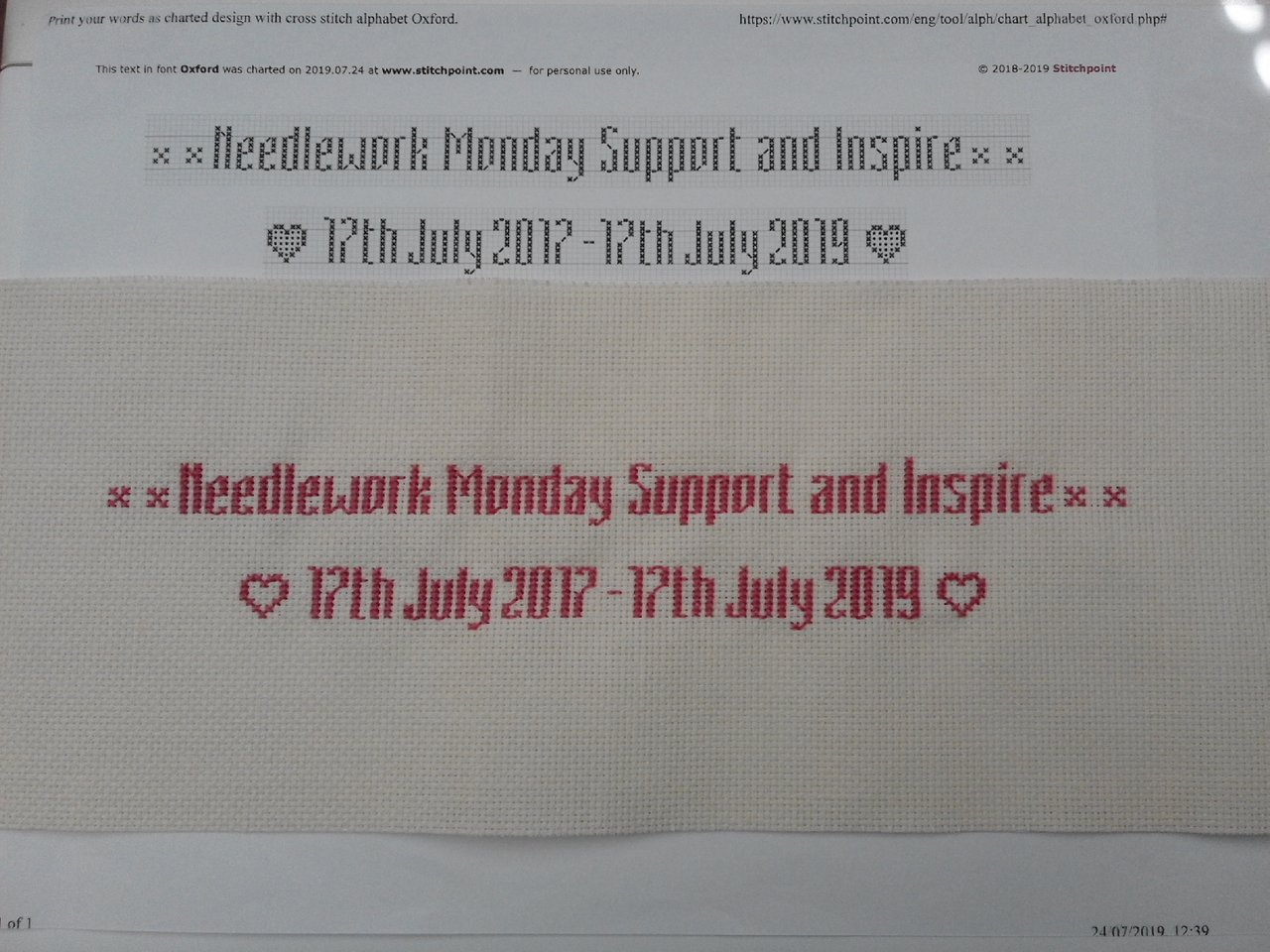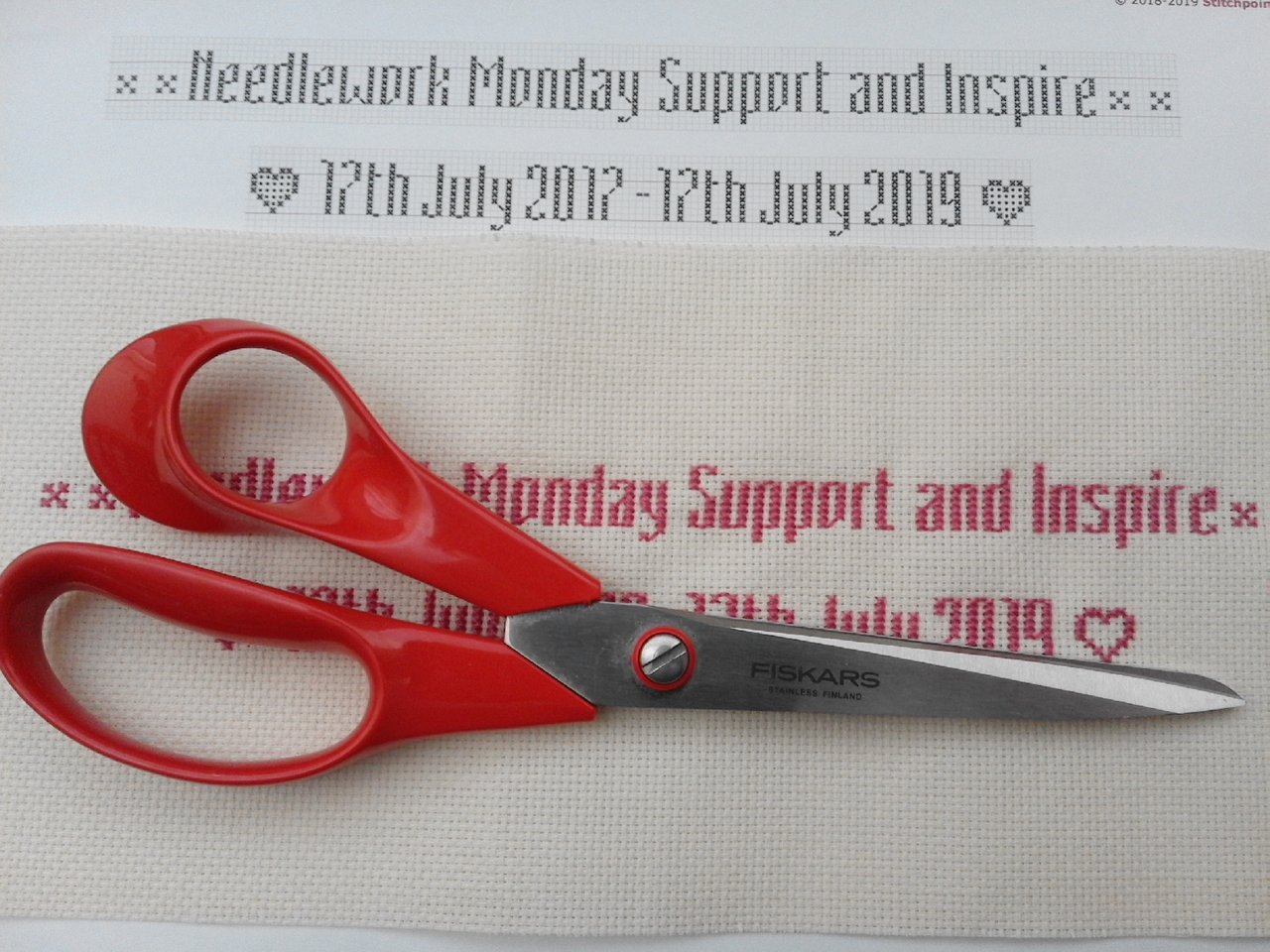#needleworkmonday | 2 Year Anniversary - Sampler
19 comments
It is two years since the #needleworkmonday tag came into being, bringing together needlework artists and crafters every Monday to share their creations, inspirations and challenges. A little contest has been running through July to celebrate and this is my entry.

I was at a loss about what to do until last Wednesday when I remembered my interest in samplers. I found and created a simple banner.
I chose Oxford font because it reminded me of the beautiful Italic script we learned at primary school and I liked the Ecclesiastical look, like stone-carved monuments in churches. It's taken about three days' work so far, I would guess, to make. I was working quite slowly, listening to the radio and enjoying the sensation of stitching. Many thoughts ran through my head, about #needleworkmonday, the many friends I have made here, and the stillness and slow rhythm of making each stitch and letter.
In their earliest form, samplers were put together as personal reference works for embroiderers: trials of patterns and stitches which had been copied from others, records of particular effects achieved which could be recreated again. They would have been the work, not of children, but of more experienced embroiderers, and some, from their quality, of professionals.

Linen sampler embroidered with silk, by unknown maker, Germany, 1500-1550. The , in London, has built up a collection of over 700 examples, ranging in date from the 14th or 15th century to the early 20th, reflecting the contribution made by samplers towards documenting the history of embroidery, its teaching and practice.
In later centuries, samplers became more formulaic as they became part of a girl's education and, to me, less interesting. I did have a look through the V&A's collection to see if they had any contemporary samplers or whether there was any reference about how samplers have influenced contemporary artists, but there didn't seem to be any.
I was reminded of several artists as I was stitching. Cezanne, with his monumental Bathers, the canvas bare in some places, highlighting the contrast between ground and paint or, in my case, canvas and stitch.

Source I've always loved this painting since I first saw it in an exhibition in London in 1996. You can see the bare patches of canvas on some of the figures. I was fascinated by that and the way I feel greedy when I look at the painting, as if I can't take it all in.

Man on a Plain, Erich Heckel, 1917. This is a print from a woodcut. It is in the Leicester collection of German Expressionism - quite a unique collection - and I have been to see it many times. It had a profound effect on me, the technique, the starkness created by the engraving and the subject matter (the oppressiveness and strain of the 1914-1918 war) when I first saw it, and it has stayed in my memory, the harshness created by the contrast between ink and ground.

TR III, Anni Albers, 1969-1970. This is an embossed print, with the way the light falls on the planes of the paper creating the contrast. In spite of , Anni Albers work has become part of my creative memory and language, that I call to when I'm trying to understand my own experiments.

My simple design is so far from these and yet, creating it encompassed so many other thoughts and feelings and experiences. I am not sure what I am going to do with it. One idea was to use it as the cover for a sheath for my dressmaking shears. That way, it would be in use every day and I would always be reminded of #needleworkmonday and its place in my life and development. It was posting each week in #needleworkmonday, focusing my ideas, that made me realise how important making (regardless of the outcome, its acceptability to others) was to me and how I wanted to spend my time in constant experiment with ideas. If any of them became a finished piece of work, that was another matter.
I like the idea of samplers as a personal commemoration, a gift designed entirely for the occasion, from one person to another, celebrating the rites of life: weddings and new babies and lives lived. Whenever I hear Forever Young, I'm reminded of my mother ... "May God bless and keep you always May all your wishes come true May you always do for others And let others do for you May you build a ladder to the stars And climb on every rung May you stay May you stay forever young." She was an atheist, but the sentiment holds. That would some sampler, commemorating her life.
Bob Dylan: Forever Young. Thanks to @crosheille for initiating #needleworkmonday and to @crystalize, @marblely and @muscara for their support for the community.



Comments